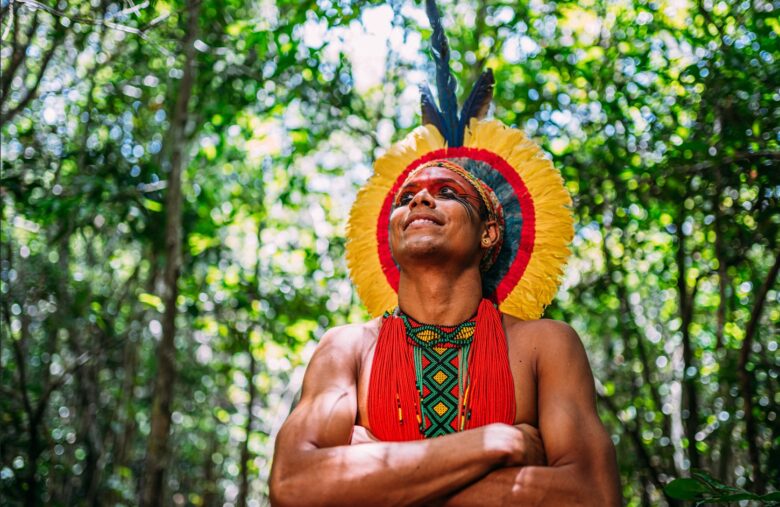Nestled in the heart of the Caribbean, Trinidad emerges as a land steeped in vibrant cultural and natural wonders. This island, a gem in the azure waters, is a tapestry woven with rich threads of history, pulsating rhythms of diverse cultures, and an unspoiled natural landscape that captivates the soul. Trinidad is not just a place on the map; it’s a living, breathing entity that tells a thousand tales through its folklore and myths.
As we delve into the heart of Trinidad’s heritage, we find ourselves enveloped in a world where every corner, every street, and every forest whispers stories of yesteryears. The folklore of Trinidad is a colorful mosaic, showcasing a blend of African, Indian, European, and indigenous influences. These stories are not mere tales; they are the embodiment of Trinidad’s soul, revealing the essence of its people, their beliefs, and their way of life.
The myths of Trinidad, rich and varied, serve as a window to understanding the island’s past and present. They bring to life characters and legends that have been passed down through generations, becoming a fundamental part of the cultural fabric. Exploring these myths is like embarking on a journey through time, where the lines between the mystical and the real blur, giving us a glimpse into the heart of Trinidadian culture.
In this exploration, we are not just uncovering tales for entertainment; we are preserving a legacy. These stories are crucial in keeping the culture alive, in connecting the past with the present, and in sharing the uniqueness of Trinidad with the world. As we embark on this journey through Trinidad’s folklore and myths, we open doors to a world where imagination and reality coalesce, creating a rich tapestry of cultural traditions that beckon to be explored and cherished.
History and Origins of Trinidad’s Folklore
The enchanting island of Trinidad, with its kaleidoscope of cultures, is a fertile ground for a rich and diverse folklore. The history of Trinidad’s legends and myths is as complex and varied as the island’s past, rooted deeply in the soil tilled by generations of diverse inhabitants. The origins of these stories are an intricate blend of the island’s indigenous, African, Indian, European, and even Asian heritage, each adding their unique hues to the cultural tapestry.
The indigenous peoples, the first narrators of this land, left behind a legacy of tales that speak of the island’s creation, its natural wonders, and the spirits that they believed roamed the earth, sea, and sky. These stories, rich in symbolism and reverence for nature, laid the foundation for Trinidad’s folklore.
The arrival of Africans, brought to the island through the transatlantic slave trade, significantly influenced Trinidad’s cultural landscape. They brought with them a wealth of oral traditions, rich in proverbs, folktales, and legends. These stories, often passed down through generations, served as a means of preserving their history and identity in a foreign land. The African influence is particularly evident in tales that speak of strength, resistance, and the unbreakable spirit of the people.
The Indian indentured laborers, who came to Trinidad in the 19th century, introduced a new dimension to the island’s folklore. Their myths and legends, infused with the ethos of Hindu and other Indian cultural beliefs, added diversity to the existing narrative tapestry. These stories often revolve around gods, goddesses, and moral lessons, reflecting the spiritual and philosophical depth of Indian culture.
European colonization also played a significant role in shaping Trinidad’s folklore. The tales and legends from European settlers and missionaries mingled with local narratives, creating a unique fusion. These stories often bear the marks of Christian influences and European folklore traditions.
Over time, these diverse cultural strands interwove to create a rich folklore unique to Trinidad. This folklore is not just a collection of stories; it is a living history of the island, a testament to its resilience and the adaptability of its people. It reflects the struggles, hopes, dreams, and values of generations of Trinidadians, making it an essential part of the island’s cultural heritage.
In exploring the history and origins of Trinidad’s folklore, we uncover more than just tales; we unearth the soul of an island that has thrived on diversity and has turned its varied history into narratives of enduring strength and beauty.
Popular Myths and Legends
Trinidad, a land where the past dances with the present, is home to a myriad of myths and legends that are as captivating as they are enlightening. Among the most renowned are the tales of La Diablesse and Papa Bois, each echoing the island’s unique blend of cultures and values.
La Diablesse: The tale of La Diablesse is one shrouded in mystery and allure. She is often depicted as a beautiful woman, dressed in a flowing white gown, her face hidden by a wide-brimmed hat. La Diablesse is said to roam the roads and lure unsuspecting men into the forest, never to be seen again. This legend speaks volumes about the Trinidadian perspective on the supernatural, blending elements of fear, respect for the unknown, and the inherent caution in dealing with seductive, yet potentially dangerous, forces. La Diablesse is more than just a spooky tale; she is a symbol of the island’s respect for the mystical and the unexplained.
Papa Bois: In stark contrast to La Diablesse, Papa Bois embodies the spirit of conservation and respect for nature. Described as the protector of the forests and animals, he is often depicted as an old man with a long beard, cloaked in leaves. The legend of Papa Bois is a testament to Trinidad’s deep connection with nature and a reminder of the importance of preserving the natural environment. His story highlights the cultural value placed on stewardship of the earth, a belief deeply ingrained in Trinidadian folklore.
Other notable Trinidadian legends include:
- The Soucouyant: A shape-shifting, blood-sucking witch who sheds her skin at night to hunt for victims. This legend reflects the island’s fascination with the supernatural and serves as a metaphor for hidden dangers and deceit.
- The Douens: Mysterious, child-like creatures with backward feet, known for leading children astray. This legend underscores the importance of protecting the young and innocent, a value deeply held in Trinidadian society.
These stories, rich in imagery and symbolism, are not mere entertainment. They serve as a mirror, reflecting the values, fears, and beliefs of the Trinidadian people. The myths of La Diablesse and Papa Bois, along with other local legends, offer a unique insight into the island’s cultural psyche. They reveal a community deeply connected to its past, yet dynamically evolving, always weaving new threads into the rich tapestry of its folklore.
In understanding these legends, one gains not just a glimpse into the imagination of Trinidad but also an appreciation for the complex tapestry of beliefs and values that shape this vibrant island nation.
Folklore and Trinidad’s Nature
In Trinidad, the verdant rainforests, meandering rivers, and rugged coastlines are not just natural landscapes; they are realms where folklore and biodiversity intertwine, creating a unique narrative that resonates deeply with the island’s identity. The relationship between Trinidad’s rich myths and its diverse natural environment is a testament to how folklore can shape our understanding and appreciation of nature.
The Interplay of Myth and Nature: The stories of Trinidad’s folklore often feature elements of the natural world, with forests, animals, and rivers playing pivotal roles. These tales serve as a cultural bridge, connecting people to their environment. For instance, the legend of Papa Bois, the guardian of the forests, not only entertains but also imparts a crucial message about the significance of protecting wildlife and natural habitats. It encapsulates the idea that humans are not separate from nature, but a part of it, and hence responsible for its stewardship.
Folklore as a Conservation Tool: In Trinidad, folklore has become an inadvertent yet powerful tool for conservation. Myths and legends often embody the principles of respect for nature and the need for its preservation. The story of the Douens, for instance, while primarily a cautionary tale for children, also subtly emphasizes the importance of safeguarding the island’s mysterious and magical natural spaces. These stories help cultivate a sense of wonder and respect for the natural world, encouraging conservation efforts at a grassroots level.
Cultural Reflections in Biodiversity: Trinidad’s biodiversity is as varied as its folklore. The island’s ecosystems, ranging from coral reefs to mangrove swamps, are home to a plethora of species, some of which are unique to Trinidad. The folklore surrounding these species and habitats reflects the island’s deep appreciation for its natural heritage. For example, tales that involve the Scarlet Ibis, Trinidad’s national bird, not only highlight its beauty but also its ecological importance, fostering a sense of pride and a desire to protect these natural treasures.
Educating and Inspiring Through Folklore: The use of folklore in environmental education has become increasingly significant in Trinidad. By weaving ecological themes into traditional stories, educators and conservationists have found a way to inspire both the young and old to engage in environmental protection. These narratives make complex concepts like biodiversity conservation more relatable and understandable, thus fostering a culture of environmental awareness and action.
In essence, the folklore of Trinidad serves as a vibrant thread linking the island’s rich cultural heritage with its diverse natural environment. It reflects a profound understanding that the preservation of nature is inextricably linked to the preservation of cultural identity. By exploring and valuing these tales, we not only honor the island’s cultural traditions but also reinforce the importance of conserving its extraordinary natural world.
Traditional Festivals and Celebrations
In Trinidad, traditional festivals and celebrations are vibrant expressions of the island’s rich folklore and cultural heritage. Among these, Trinidad’s Carnival stands out as a kaleidoscopic spectacle, deeply rooted in the island’s history and folklore.
Trinidad’s Carnival: More than just a dazzling display of costumes and rhythm, Trinidad’s Carnival is a living museum of the island’s cultural diversity. Originating in the late 18th century, the festival has evolved from its European masquerade roots into a unique blend of African, Indian, and indigenous traditions. It is a time when the tales, myths, and legends of Trinidad come to life through music, dance, and elaborate costumes. Characters from folklore, such as the mischievous Midnight Robber or the fearsome Dame Lorraine, parade through the streets, enacting scenes from popular legends and embodying the spirit of the island’s ancestors. Carnival is not just a festival; it’s a powerful symbol of resilience and unity, where the diverse threads of Trinidad’s history are woven into a vibrant tapestry of present-day celebration.
Other Cultural Festivals: Trinidad’s cultural calendar is dotted with other festivals that celebrate its folklore and traditions. The Divali (Diwali) celebration, known as the Festival of Lights, is a splendid display of Indian culture and heritage, reflecting the significant Indian influence on the island. Similarly, the Hosay Festival, commemorating the martyrdom of Imam Husayn, blends Islamic rituals with Trinidadian customs, showcasing the island’s religious and cultural plurality.
Significance for the Local Community: These festivals are more than just annual events; they are vital for community bonding and cultural preservation. They offer a space for collective expression, creativity, and storytelling, allowing generations to connect with their heritage. Festivals like Carnival foster a sense of identity and pride, uniting Trinidadians from all walks of life in a shared celebration of their history and folklore.
Cultural Education and Continuity: Through these festivals, the stories and traditions of the past are passed down to younger generations, ensuring the continuity of Trinidad’s rich cultural legacy. They serve as dynamic educational platforms, where the folklore that shapes the island’s identity is not only remembered but also reinvigorated with contemporary relevance.
In conclusion, Trinidad’s traditional festivals and celebrations, epitomized by the Carnival, are not just annual festivities; they are the heartbeat of the island’s cultural life. They encapsulate the essence of Trinidad’s folklore, weaving a vibrant narrative that spans history, culture, and community, enriching the island’s social fabric and reinforcing a collective sense of identity and belonging.
Preservation and Modern Importance
In Trinidad, the preservation of folklore and traditions is not just a nod to the past; it’s a vital part of maintaining the island’s cultural identity in the modern world. As the global landscape shifts, the efforts to keep these rich traditions alive have become more crucial than ever, bridging the gap between the past and the present.
Preservation Efforts: Numerous initiatives are underway in Trinidad to preserve its folklore and traditions. These include cultural programs in schools where children are taught traditional stories, dances, and songs, ensuring that the next generation carries the torch of their heritage. Museums and cultural centers play a significant role in this endeavor, showcasing artifacts and hosting exhibitions that tell the story of Trinidad’s folklore and history. Furthermore, oral history projects and the documentation of legends and folktales in books, documentaries, and online platforms are vital in keeping these stories accessible to a wider audience.
The Relevance in Contemporary Society: In modern Trinidadian society, folklore remains a significant source of cultural identity and pride. These stories and traditions provide a sense of belonging and a connection to the island’s ancestry, crucial in a world where globalization can dilute cultural uniqueness. Folklore also offers a means of understanding contemporary social and environmental issues, with many tales emphasizing themes like community, respect for nature, and the strength of the human spirit.
Folklore in Arts and Media: Trinidad’s folklore has found new life in the arts and media, with local artists, writers, and filmmakers drawing inspiration from traditional tales to create contemporary works. This not only helps in preserving these stories but also makes them relevant to a modern audience. Music, a pivotal aspect of Trinidadian culture, often incorporates elements of folklore, keeping the island’s heritage alive in its rhythms and lyrics.
Cultural Tourism: Folklore also plays a significant role in Trinidad’s cultural tourism. Festivals, storytelling events, and folklore tours attract visitors from around the world, eager to experience the island’s rich cultural heritage. This not only boosts the economy but also fosters a greater appreciation and understanding of Trinidadian culture globally.
In essence, the preservation and modern importance of Trinidad’s folklore are about more than just safeguarding the past; it’s about enriching the present and inspiring the future. As Trinidad navigates the complexities of the 21st century, its folklore remains a beacon of cultural identity, a source of communal strength, and a testament to the enduring spirit of its people.
Conclusion
The exploration of Trinidad’s folklore and myths reveals a tapestry of stories as vibrant and diverse as the island itself. These tales, woven from the threads of history, culture, and nature, are not just remnants of the past but living elements of Trinidad’s present and future. They encapsulate the spirit of an island that has thrived on diversity, resilience, and the rich interplay of various cultures.
The importance of Trinidad’s folklore lies in its ability to connect us with the island’s heritage, offering insights into the values, beliefs, and traditions that have shaped the Trinidadian way of life. These stories and legends serve as a cultural compass, guiding the community through the complexities of modern life while retaining a strong sense of identity and pride. They are a reminder of the power of storytelling in preserving history, educating the young, and fostering a deep appreciation for one’s cultural roots.
As we delve into the folklore of Trinidad, we uncover more than just tales of mythical beings and legendary heroes; we discover a world where every story is a piece of a larger cultural mosaic. The tales of La Diablesse, Papa Bois, and countless others are not just entertainment but invaluable cultural artifacts, each holding a mirror to the society from which they emerged.
In encouraging further exploration and appreciation of Trinidadian culture, we invite readers to embark on a journey that is both educational and enlightening. The rich folklore of Trinidad is a gateway to understanding the island’s unique cultural landscape, offering lessons that are relevant even in today’s globalized world.
For those who wish to experience the magic of Trinidad’s culture firsthand, a visit to the island is an opportunity to immerse oneself in a world where folklore, music, dance, and art come alive. Trinidad awaits with open arms, ready to share its stories and traditions, inviting visitors to become a part of its ongoing narrative.
In conclusion, the folklore and myths of Trinidad are not just stories; they are the heartbeat of the island, pulsating with the rhythms of history and the melodies of diverse cultures. They deserve not only to be preserved and cherished but also to be celebrated and shared, continuing to inspire and unite generations to come.
‘Trinidad’s Treasures: Top 10 Hidden Secrets Revealed’ A fascinating guide that unveils the lesser-known secrets of Trinidad.
This e-book dives deep into the less explored aspects of the island, highlighting secret beaches, natural trails, hidden historical sites, local culinary delights, off-the-radar festivals, and unknown artistic scenes. It’s an invitation to explore the true essence of Trinidad, away from conventional tourist routes, providing an authentic experience rich in culture, history, and natural beauty.




